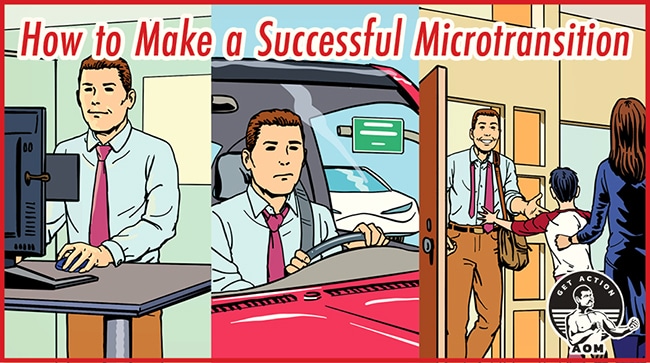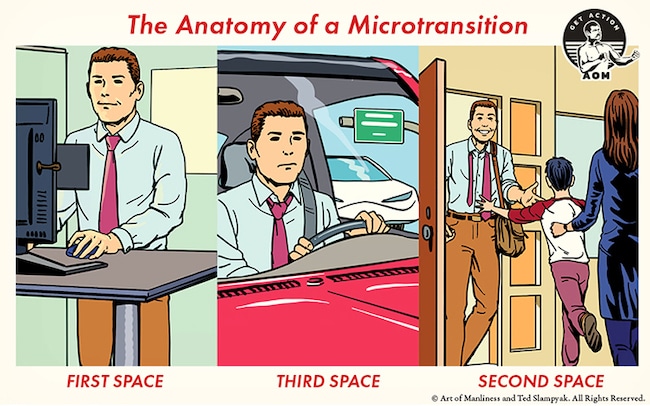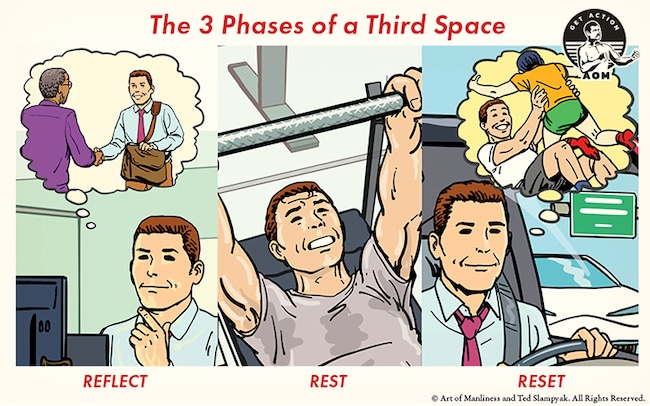
Everyone is required to wear different hats throughout their day.
You move from generating spreadsheets to brainstorming product ideas; from the office to your home; from coaching a Little League team to talking to your wife about a problem with your household budget.
Sometimes we have to make these shifts between tasks and responsibilities at the, well, drop of a hat. As a consequence, the stresses and concerns of one role can leak into another, making them all feel kind of muddled.
Fortunately, there’s a better way to make these kinds of pivots — one that will allow you to show up to each of your roles in a more present and productive way.
We’ll share it with you today.
The Anatomy of a Microtransition

Dr. Adam Fraser, a performance expert, calls the shifts we make between roles and responsibilities microtransitions.
I first learned about microtransitions from Fraser’s book The Third Space. Be sure to check out our interview with him about the topic; it was one of my favorite episodes this year.
According to Dr. Fraser, a microtransition consists of three “spaces”:
- The First Space: the physical or mental space you’re currently in.
- The Second Space: the physical or mental space you’re moving into.
- The Third Space: the interval between the First and Second Space where you decide how you will show up in the Second Space.
We experience multiple microtransitions throughout the day. When you move from work to home, that’s a microtransition. The First Space is work, the Second Space is home, and the Third Space is your commute between work and home.
You don’t have to physically move to another location to experience a microtransition. They can also be mental pivots. For example, when you shift from doing creative work to doing administrative work at your job, that’s a microtransition. The First Space is doing the creative work, the Second Space is doing the admin work, and the Third Space is that short interval where you put one project aside and toggle over to the next.
When you shift from engaging with one patient or client to another, that’s a microtransition too. Client A: First Space; Client B: Second Space; moment between meeting with Client A and meeting with Client B: Third Space.
The 3 Phases of the Third Space

According to Dr. Fraser, by utilizing the Third Space — that interval where you shift from your current physical/mental space to your next physical/mental space — you can create more calm in your life and feel more fulfilled and engaged in all of its facets.
Third Space moments can be long or short. A 30-minute commute home from work is a Third Space. So is the 60-second pause between seeing Patient A and seeing Patient B. It doesn’t matter how long or short a Third Space moment is; you can use it to your advantage.
Just as a microtransaction is broken into three phases, the Third Space itself also has three phases. According to Dr. Fraser, by intentionally taking yourself through the following three steps, you can use a Third Space to make an effective shift from one role/responsibility to another:
Phase 1: Reflect
During the Reflect phase of a Third Space moment, you’re looking back on how things went during your First Space. You’re going to tie up loose mental ends, review the content of that day/task, and close the file on it.
One of the main goals of this Reflect phase is to make sure whatever negative experiences or emotions you experienced in your First Space don’t carry over into your Second Space.
According to Dr. Fraser, a big reason men have a hard time transitioning from work to home is that they bring the mental garbage they accumulated at work back to their family. They might have had a boss get angry at them during the day, and they’re still stewing about it when they greet their kids at night.
Think of the Reflect phase like the decontamination chamber lab technicians use after working with viruses.
Dr. Fraser recommends asking yourself the following questions during the Reflect phase:
- What went well in my previous task or role?
- What did I achieve during that time?
- How did I improve or learn from that experience?
Even when things didn’t go great for you, look for wins. Sure, your presentation didn’t go as planned, but maybe you did a good job making the best of a bad situation. Maybe you didn’t land the deal with client X, but you improved the negotiation skills you’ve been working on. Perhaps the team you coach lost the game, but the boys did a great job implementing the things you’ve been working on during practice.
You’re not trying to be Pollyannaish about this. You just want to ensure you’re balanced in assessing how things went in your First Space. We tend to glom on to the negative. Looking for wins during your reflection phase can ensure you move into the Second Space with some positivity.
Phase 2: Rest
The second phase of the Third Space is Rest. This phase is about calming your mind and preparing yourself for the upcoming transition. You can use various techniques to achieve a state of presence and focus, and they can be done in a few seconds or extended to an hour.
Dr. Fraser recommends doing one or more of the following things:
- Deep Breathing: Take a few moments to focus on your breath. Inhale deeply through your nose, hold for a few seconds, and exhale slowly through your mouth. This simple practice can help reduce stress and increase mental clarity.
- Mindfulness Meditation: Find a quiet space and dedicate a few minutes to mindfulness meditation. Focus your attention on the present moment, observing your thoughts and sensations without judgment. This practice can help cultivate a sense of calm and centeredness.
- Physical Exercise: Engage in physical activity that allows you to be present in your body. Whether it’s a quick walk, a yoga session, or a full workout, moving your body can help release tension and increase focus.
Even though this is called the “Rest” phase, that doesn’t mean you need to be inert. You’re resting from whatever your previous task was, and from cognitively-taxing work in general. But you can use this time to engage in mind-clearing and/or flow-inducing activities, whether that’s exercise or a hobby like painting. Remember the old adage: A change is as good as a rest.
Phase 3: Reset
The final phase of the Third Space is Reset. This phase involves setting clear intentions for your upcoming task or role. By consciously defining how you want to show up and what you want to achieve, you can set yourself up for success and create a positive impact in your subsequent interactions.
To reset effectively, consider the following steps:
- Define Your Intent: Clarify your intention for the next task or role. What do you want to accomplish? How do you want to show up? Setting a clear intention will help guide your actions and behaviors.
- Visualize Success: Take a moment to visualize yourself successfully navigating the upcoming task or role. Imagine yourself performing at your best and achieving your desired outcomes.
- Adapt Your Behavior: Sometimes when you arrive at your Second Space, how you imagined it would be, isn’t how it is. Maybe you pictured coming home from work to walk into a domestic idyll, but instead, the house is a mess, the kids are quarreling, and your wife’s at her wit’s end. Adapt your behavior to this reality, but keep your intent to be a cool, calm, and collected dad.
Real-Life Applications of Making Effective Microtransitions
Now that we’ve explored the three phases of a Third Space, let’s apply this knowledge to real-life scenarios. Here are two examples of how you can use microtransitions to improve your daily life:
Transitioning Between Work Tasks
You can use the power of the Third Space as you transition from different tasks at work.
When you shift from one meeting or project to the next, take a five-minute walk. During that time, reflect on how the previous task went, center yourself with your walking, and reset your intentions for how you want to show up to your next meeting or project.
Dr. Fraser also shares an example of a doctor who, after finishing a visit with one patient, pauses and touches the doorknob before entering the room of the next. As he does so, he spends just a few seconds resting and resetting by taking a deep breath and asking himself: “If this was my mother or father, how would I want a doctor to treat them?”
Transitioning From Work to Home
If you’re tired of arriving home (Second Space) from work (First Space), stressed, impatient, and irritable, use your commute as a Third Space to smoothly transition from work to home.
While you’re driving home, take a few minutes to reflect on what you accomplished during your work day. Look for wins even if things didn’t go well. As you reflect, take some deep breaths and listen to music that makes you feel great. As you get closer to home, mentally decide how you will show up with your family. What will you do to be the best husband and dad you can be?
Another way to add a Third Space between work and home is to hit the gym before you go home. Reflect as you drive to the gym; rest as you work out; reset as you drive from the gym to your house.
You might resist the idea of going to the gym after work, feeling like you need to get home to your family as soon as possible. But in a study Dr. Fraser did where he asked families what they most wanted when it came to their loved ones, children and spouses said the quantity of time a parent/spouse spent with them was less important than whether or not the person was present and engaged when they were together. That’s to say, it may be better to arrive home at 6:30 ready to positively participate in family life after a de-stressing session at the gym, than it is to come home at 5:30 and act like a distracted crank.
Set Yourself Up for Success for the Next Thing in Life
Recognizing and successfully utilizing microtransitions is a skill that takes practice to master. Experiment to find what works for you, and don’t get discouraged if you don’t see the benefits of it right away.
Being intentional about navigating the microtransitions you experience throughout the day will better allow you to manage the overwhelm you experience. As you practice using the Third Space to reflect, rest, and reset, you’ll notice yourself becoming more centered, present, and productive in all your roles.
For more insights on how to use the Third Space to make successful microtransitions, listen to our podcast with Dr. Adam Fraser:
The post The Power of the Third Space: How to Set Yourself up for Success for the Next Thing in Life appeared first on The Art of Manliness.
0 Commentaires